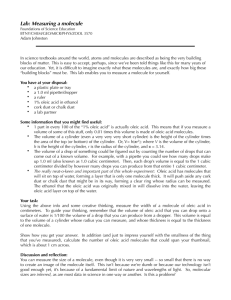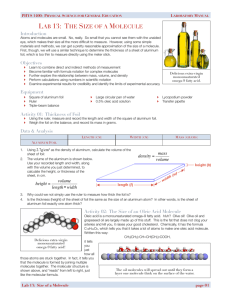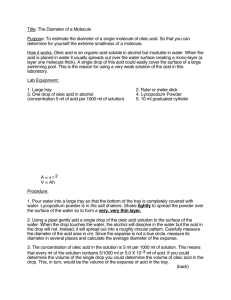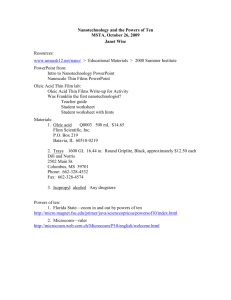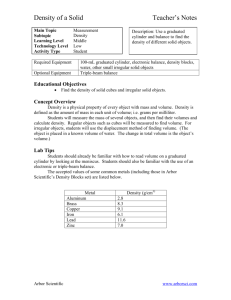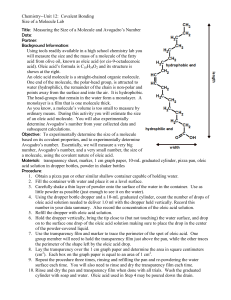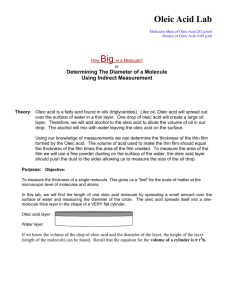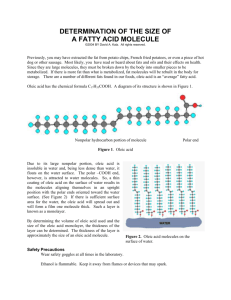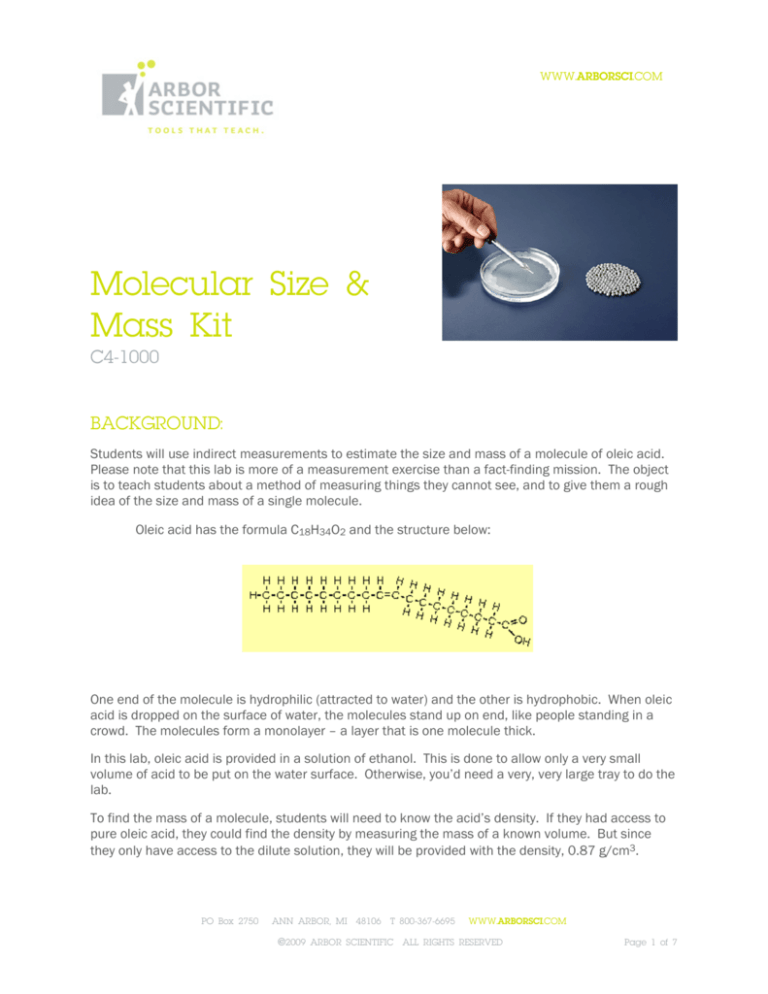
WWW.ARBORSCI.COM
Molecular Size &
Mass Kit
C4-1000
BACKGROUND:
Students will use indirect measurements to estimate the size and mass of a molecule of oleic acid.
Please note that this lab is more of a measurement exercise than a fact-finding mission. The object
is to teach students about a method of measuring things they cannot see, and to give them a rough
idea of the size and mass of a single molecule.
Oleic acid has the formula C18H34O2 and the structure below:
One end of the molecule is hydrophilic (attracted to water) and the other is hydrophobic. When oleic
acid is dropped on the surface of water, the molecules stand up on end, like people standing in a
crowd. The molecules form a monolayer – a layer that is one molecule thick.
In this lab, oleic acid is provided in a solution of ethanol. This is done to allow only a very small
volume of acid to be put on the water surface. Otherwise, you’d need a very, very large tray to do the
lab.
To find the mass of a molecule, students will need to know the acid’s density. If they had access to
pure oleic acid, they could find the density by measuring the mass of a known volume. But since
they only have access to the dilute solution, they will be provided with the density, 0.87 g/cm3.
PO Box 2750
ANN ARBOR, MI 48106 T 800-367-6695
WWW.ARBORSCI.COM
©2009 ARBOR SCIENTIFIC ALL RIGHTS RESERVED
Page 1 of 7
Students will model the experiment first by using spherical bb’s. Dispense the bb’s so that each
group has about 50mL of bb’s.
KIT CONTENTS:
1L Oleic Acid Solution (5mL acid in Ethanol)
1 piece of chalk
12 eye droppers
~4000 bb’s (~400mL)
Also needed for each group:
Large flat pan – pizza pans are ideal.
Metric Ruler
100mL graduated cylinder
10mL graduated cylinder
Micrometer (optional)
Access to a balance
PREREQUISITES:
Students should have a good understanding of the concept of density and geometric formulas for
area and volume. They should be able to solve simple algebraic formulas and solve a proportion. A
good grasp of scientific notation is also very helpful.
FORMULAS AND HINTS:
Depending on the level of your students, you might want to put some or all of the following reminders
on the board or discuss and practice them before the lab. High school chemistry students, for
instance, should be familiar with these basic geometry formulas and algebraic manipulations. Give
just enough guidance that students don’t get caught in the geometry and lose track of the meaning
of the lab.
5. (and 15) Radius is half of diameter.
6. Area of a circle: A = πR2(and 17) Cylinder volume formula, solved for height of cylinder: h
7. (and 18) Hint: How many bb diameters (molecule lengths) equals the height of the cylinder
from #6 (#17)?
9. Volume of a sphere:
4
V R 3
3
10. Don’t forget to subtract the mass of the container that holds the bb’s.
12. (and 21) Density formula, solved for mass: m = ρV
PO Box 2750
ANN ARBOR, MI 48106 T 800-367-6695
WWW.ARBORSCI.COM
©2009 ARBOR SCIENTIFIC ALL RIGHTS RESERVED
Page 2 of 7
V
A
24. Percent error:
%error
( actual measured )
*100%
actual
ANSWERS:
Naturally, as in any experimental lab, you can expect a range of results. Here are the accepted
values:
BB radius: 0.45cm
BB mass: 0.37g
Acid molecule length: 1.8 x 10-7cm
Acid molecule mass: 4.68 x 10-22g
Acceptable experimental results for the acid molecule will be in the correct order of magnitude (10-7
or 10-22). If students are much farther off than that, they might want to recalculate or repeat the
experiment. (Be sure to clean the pan thoroughly between trials.) Don’t let students worry if they get
a very high percent error (100% or more) for #23. Keep in mind that the percent difference between
1.0 x 10-7cm and 2.0 x 10-7cm is 100%, but they can both be considered very accurate for this lab.
REFERENCES:
Robinson, Paul. Conceptual Physics Laboratory Manual: 4th edition. Prentice Hall.
p. 173 and p. 175
Oleic acid structure diagram:
http://animalscience.tamu.edu/nutr/202s/LectureOutlines/lipids.html. (viewed 9/9/2003).
Visual acuity information:
http://www.nde-ed.org/EducationResources/CommunityCollege/PenetrantTest/Introduction/visualacuity.html.
(viewed 9/9/2003).
ACKNOWLEDGEMENTS:
Many thanks to Mike Horton, Perris High School, for his input on this product.
RELATED PRODUCTS:
Micrometer (P1-1040). 25mm x 0.01mm.
Basic Lab Supply Pack (C3-3000). Includes beakers, graduated cylinders, flasks, test tubes, and
more for outfitting student chemistry lab kits.
PO Box 2750
ANN ARBOR, MI 48106 T 800-367-6695
WWW.ARBORSCI.COM
©2009 ARBOR SCIENTIFIC ALL RIGHTS RESERVED
Page 3 of 7
Name: ___________________
Molecular Size & Mass
USING DIRECT MEASUREMENT TO FIND MOLECULAR SIZE AND MASS
You will be indirectly measuring the size and mass of a single molecule of oleic acid. First, the
process will be modeled with spherical bb’s.
OBJECTIVES:
To estimate the length of a molecule of oleic acid.
To estimate the mass of a molecule of oleic acid.
MATERIALS:
BB’s
100mL graduated cylinder
Metric Ruler
Oleic Acid solution (5mL acid in 1000mL of
solution)
Eye dropper
Large tray or pizza pan
Water
Chalk dust
10mL graduated cylinder
PROCEDURE:
Model: Diameter of a BB
1. Use the 100mL graduated cylinder to find the volume of bb’s. _________________________
2. 1mL = 1 cm3. Record the volume of bb’s in cm3. __________________________
3. Pour the bb’s out onto the tray and arrange them into a closely packed circle, 1 bb thick.
4. Measure the diameter of the circle in 3 places and find the average diameter.
Avg. Diameter: _____________________
5. Find the area of the circle.
Area: _____________________________
6. The circle of bb’s is really a very short cylinder, 1bb high. The volume of a cylinder can be
found by multiplying its top area by its height. V A h . Find the height of the cylinder.
7. What is the diameter of a single bb?
__________________________
8. If you have a micrometer, directly measure the diameter of a bb.________________________
PO Box 2750
ANN ARBOR, MI 48106 T 800-367-6695
WWW.ARBORSCI.COM
©2009 ARBOR SCIENTIFIC ALL RIGHTS RESERVED
Page 4 of 7
Name: ___________________
Molecular Size & Mass
MODEL: MASS OF A BB
9. Use the diameter from #7 to find the volume of a single bb.
Volume =__________________________
10. Measure the mass of the entire volume of bb’s. ________________________________
11. Calculate the density (ρ) of the bb’s (use the total volume of bb’s from #1).
m
V
12. Use the density from #11 and the volume from #9 to find the mass of a single bb.
EXPERIMENT: HEIGHT OF AN ALEIC ACID MOLECULE
An oleic acid molecule is not a sphere – it is elongated like a hot dog. The acid is less dense than
water. One end is attracted to water and the other is repelled, so when a drop of acid is placed on
water, the molecules stay on top of the water and group side-by-side, like people in a crowd.
13. Fill the tray with water about 1cm deep and place it on a level surface. Allow the water to
settle. Lightly scrape a piece of chalk over the water until a fine dust is on the surface. (The
dust should be barely visible.)
14. Use the eyedropper to gently add a single drop of oleic acid solution to the center of the tray.
The alcohol in the solution will dissolve into the water, but the acid will stay on top. Measure
the diameter of the circle in at least 3 places and find the average.
Avg. Diameter: _____________________
15. Find the area of the circle.
Area: _____________________________
PO Box 2750
ANN ARBOR, MI 48106 T 800-367-6695
WWW.ARBORSCI.COM
©2009 ARBOR SCIENTIFIC ALL RIGHTS RESERVED
Page 5 of 7
Name: ___________________
Molecular Size & Mass
16. The volume of oleic acid in the single drop of dilute solution is much less than the volume of
the whole drop. You need to know the volume of only the acid.
a. Use the eye dropper to fill the 10mL graduated cylinder to a volume of 3cm3. (Remember to
measure to the bottom of the meniscus.) Record the number of drops in 3cm3. Do this 3
times and find the average.
Drops in 3cm3 ______________________
b. Divide 3cm3 by the number of drops in 3cm3 (#16a) to find the volume of one drop.
Volume of 1 drop ___________________
c. The acid solution contains 5mL of acid in 1000mL of solution. Use the proportion below to
find the volume of acid in one drop.
5mL _ acid
Volume _ acid _ in _ 1 _ drop
1000mL _ solution Total _ volume _ of _ 1 _ drop _(#16b)
17.
The volume you found in #16c is the volume of the cylinder of acid. Find the height of the
cylinder. ( )
18.
What is the height of a single acid molecule? __________________________
Experiment: Mass of a molecule of Oleic Acid
19.
Use the height from #19 to find the volume of a single molecule. (Approximate the
molecule as a cylinder, with a diameter equal to the one-tenth of the height.)
V=_____________________________
20.
If you had access to pure oleic acid, you could measure the mass of a certain
volume to find its density. Since you only have the dilute solution, use a density of 0.87
g/cm3.
PO Box 2750
ANN ARBOR, MI 48106 T 800-367-6695
WWW.ARBORSCI.COM
©2009 ARBOR SCIENTIFIC ALL RIGHTS RESERVED
Page 6 of 7
Molecular Size & Mass
21.
Name: ___________________
Use the density from #20 and the volume from #19 to find the mass of a single molecule.
Extension: Checking Accuracy
22.
From 12 inches away, the human eye can see objects as small as 0.00886cm. How many
oleic acid molecules lined up end-to-end would it take for a human to see the length of the line?
23.
The molar mass of oleic acid is 282.4654 grams. Divide this mass by Avogadro’s number
(6.02 x 1023) to find the actual mass of one molecule.
24.
error.
Compare your experimental mass (#21) to the answer to #23 and calculate your percent
PO Box 2750
ANN ARBOR, MI 48106 T 800-367-6695
WWW.ARBORSCI.COM
©2009 ARBOR SCIENTIFIC ALL RIGHTS RESERVED
Page 7 of 7

